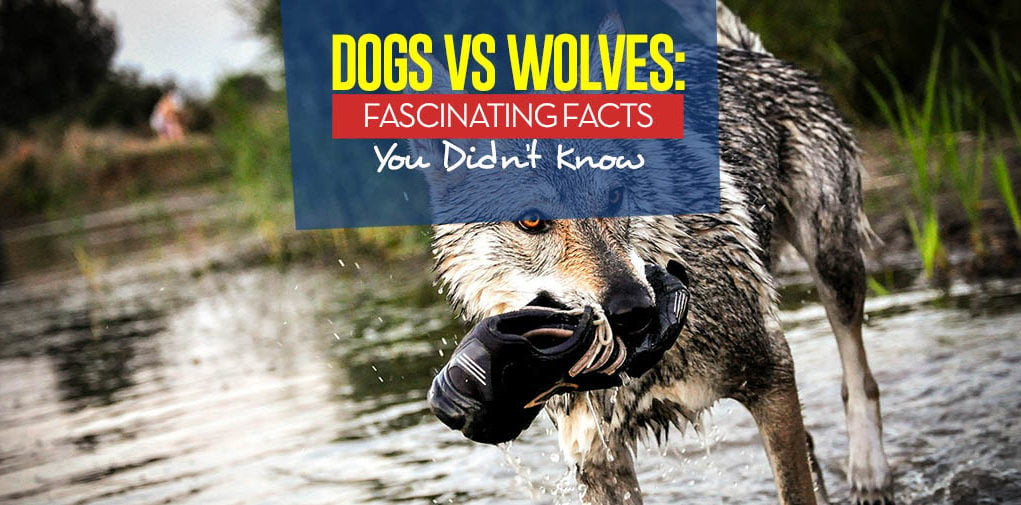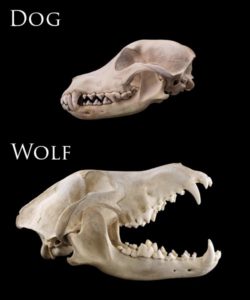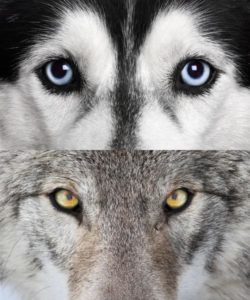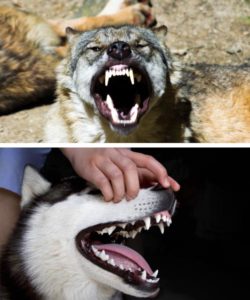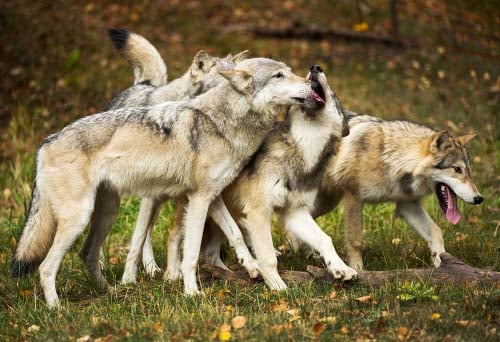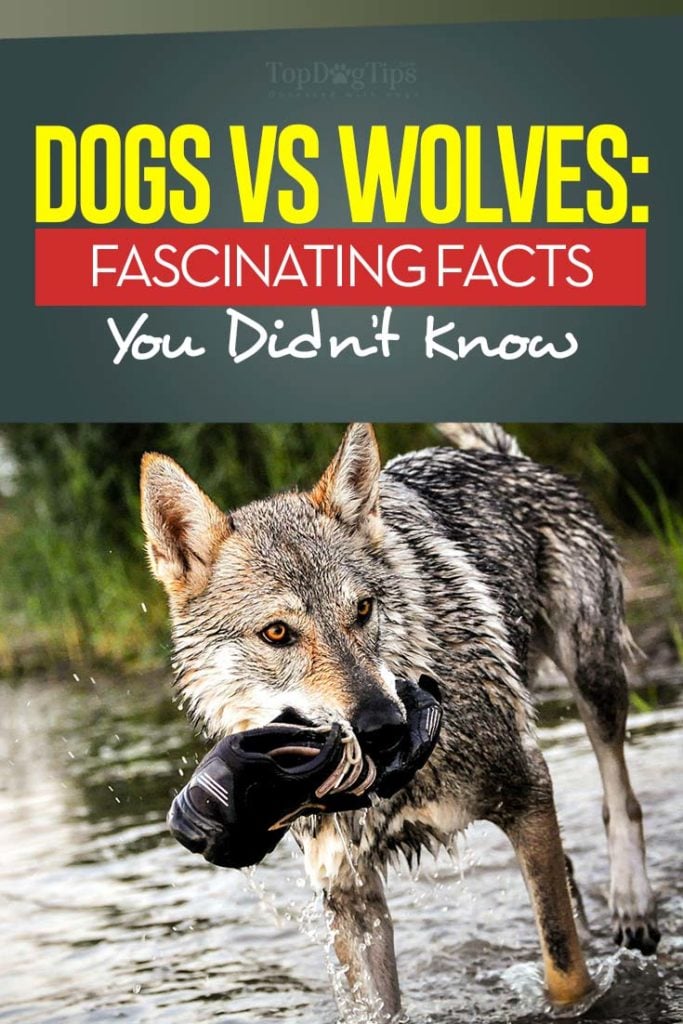Table of Contents
Wolves are majestic and awe-inspiring creatures, just like many domestic dogs can be.
While some believe that dogs are still very similar to their wild cousins (particularly in diet, survival, and sometimes training), science shows this isn’t always true.
There are a few similarities between dogs and wolves, but they are rare.
Below are the ten key differences between these two great mammals and how wolves and dogs differ psychologically and physiologically.
READ THIS: History of Dogs through Science
Differences between Wolves and Dogs
1. Teamwork
The wolf can accomplish things by bringing together their pack and using teamwork, whereas dogs do not have that instinct or the skills needed for this process.
For example, in one study experiment (1), the participants were divided into pairs with another animal like them.
The goal was to move a tray of food within reach.
To do this, they had to pull a rope simultaneously. In the first test, 5 out of 7 wolf teams completed the task, whereas only 1 out of the 8 dog teams could.
The study even showed that the wolves would stand and wait for a partner because they already knew they couldn’t do it alone.
2. Brains
A wolf’s brain is larger than a dog’s brain (2). This accounts for the results of many experiments where the wolf beats out the dog.
Like the above “teamwork” experiment, in another study test that contained logic cues, the wolf again beat the dog (3).
Where the wolf may be better at certain things, the dog wins out in tests of social ability (4).
This makes sense because dogs have about 15,000 years of selective breeding to make them fit in with human society, whereas wolves still use the “fight or flight” instincts to get through the day.
3. Speed
If you put a wolf and most breeds of dog in a race, you can bet on the wolf winning.
The wolf clocks in at 38 mph (5), while the average speed of a dog is about 20 mph, and almost all dogs top out at only 31 mph max speed.
This is partly because wolves' long, skinny legs are positioned close together.
However, if you put them next to some of the fastest dog breeds, usually sight hounds like a Greyhound, an Afghan Hound, or a Whippet, the wolf will be left in the dust.
These dogs can allegedly run as fast as 50 mph (6).
In fact, selective breeding has led to some dogs being even faster than the cheetah, the fastest mammal on the planet (7). This is one category where breed definitely matters.
4. Crepuscular
The word crepuscular means an animal is most active at dawn and dusk.
While wolves are known as crepuscular mammals, so are dogs (8).
This is one of those rare instances where the dog has not evolved too far from its original ancestors.
Their eyes shine in the dark because of a reflective material called tapetum (9).
This makes the glow often seen in photographs or a flash of light at night.
Tapetum allows wolves and dogs to see well in dimmer light.
5. Species
Dogs (Canis lupus familiaris) are in the same family as foxes and wolves (10), but while they are a different species than foxes, they are the same species as the wolf (Canis lupus).
Dogs are a subspecies of the larger wolf species (11).
A dog and a wolf can breed, making a wolf-hybrid, but that “hybrid” can also produce offspring. This shows that they are both the same species.
Animals of different species, like donkeys and horses, make sterile offspring, like the mule (12).
6. Teeth
This falls in line with the information on the dog's and wolf's diet. Wolves have longer, thicker canine teeth than dogs (13, 14).
Their molars are also larger and more fully developed.
This reflects the life differences that today’s wolf and today’s dog have had during their development.
The wolf still hunts other animals. They need their teeth to kill and shred their prey.
The domestic dog has been eating food prepared by humans (15).
While the food is more processed now, they ate table scraps in earlier times. They have not had to hunt, kill, and shred their meal in quite some time.
7. Diet
Many people will say that dogs are carnivores and should eat only meat, just like their wild cousins.
It's true wolves are carnivores, but dogs are technically omnivores.
When it comes to genetics, ten genes that they both have to control digestion actually have key differences.
In fact, many components of the raw food trend, like beef and eggs, are actually common allergies for domesticated dogs (16).
Modern domestic dogs are not wolves. This is one of the ways they are quite different.
8. Social Structure
While some dog trainers and experts still express the importance of pack leader dog training methods (17), for most canines, this is simply not required.
Yes, there are breeds that still have the pack instinct, but most domestic dogs lost that instinct centuries ago (18).
In a wolf pack, only the alpha male and the alpha female can breed (19).
While dogs may have a loose hierarchy in a group, it usually isn’t severe.
New studies show that most dogs naturally see their human as a leader (20).
They look to their human for food, help, instructions, guidance, and comfort.
9. Prey Drive
This is the one category that does not have the same “black and white” answers when it comes to comparing a wolf with a dog.
It's a given that wolves are predatory animals.
The prey drive in them is as high as it can get in a mammal (21). If it isn’t, they can’t survive.
For domestic dogs, it depends on the breed.
Some breeds are known as hunting dogs and have been bred for their hunting skills, like retrieving, but they won’t kill.
Herding breeds, like the Border Collie and the Australian Shepherd, will chase but don’t usually kill (22).
Small lap dogs, like the Coton de Tulear, won’t chase or kill, but the Pomeranian may bite.
Guardian breeds, like the Anatolian Shepherd and the Komondor, can catch and kill whatever they see as a threat.
10. Training Ability
The psychology of training goes way back to BF Skinner and operant conditioning.
When using this as a basis for training, both the wolf and the dog can learn the behavior that is wanted.
The difference is in how they learn. The wolf is a fearful animal. It is what helps keep them alive.
Studies show that wolves are temporarily frightened when they first develop hearing and again when they develop sight. Wolves are fearful of humans, too.
That fear keeps them alive in the wild, but that fear also makes it hard to tame them (23).
Conclusion
Wolves are not dogs, and dogs are not wolves.
While they do have some similarities, the evolutionary paths split at least 15,000 years ago, and both species went in their separate ways.
While there are some very small similarities between wolves and wolf-like dog breeds, this does not make them the same species (not even close).
Overall, great care must be taken when treating a dog the way an animal in the wild lives and when treating a wild animal the way you would a dog.
Related Articles:
- Cross-Breeding of Dogs and Wolves Has Forever Changed Wolf’s Gene Pool
- Man Adopts a Dog Only to Discover That He’s Actually a Wolf
- Rescued Wolf Loves to Play Keep Away
Want to share this?


